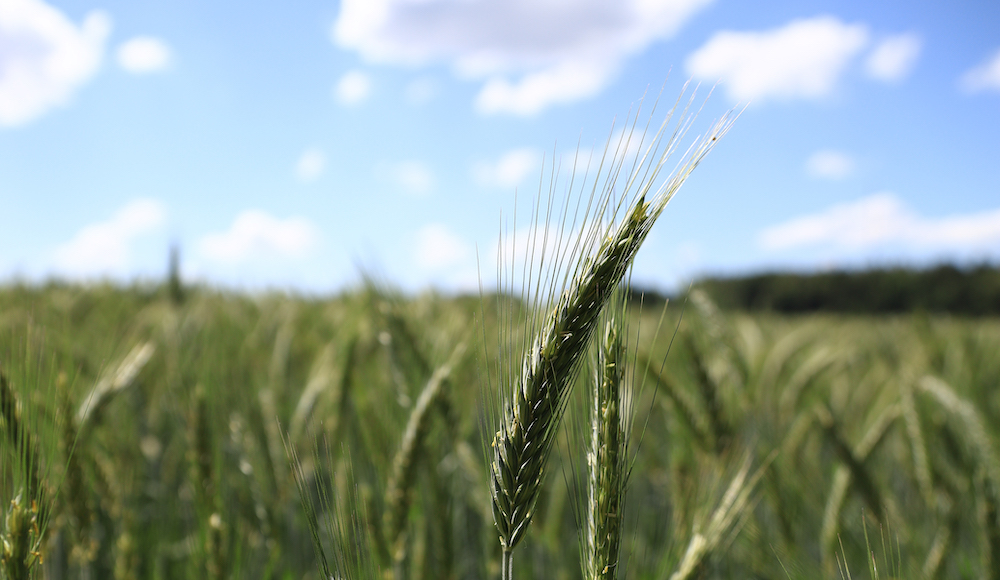Last season was dry with a slowly emerging crop, and Bentz Aldinger knew it was a question of timing when it came to deciding when to apply his herbicide. Should it be when the crop was at the ideal stage for application, or when the weeds were small and easier to manage? The choice to use Prominex herbicide on his wheat gave him the flexibility to wait until the crop was actively growing, and still get his larger weeds under control.
“Dandelions and thistles are a problem where we are and my primary objective is to get them under control,” says the Lockport, Manitoba grower. “It was so dry we thought weed control would be a challenge for any chemical, but we were really pleased with how Prominex performed. We had no escapes and it took on weeds in all different areas of my farm.”
“If we can keep the fields weed-free we won’t always have to do a glyphosate application in the fall, which is another important tool for resistance management. This product doesn’t just take down the weeds, it keeps them down. It does a very thorough job.”
Bentz Aldinger, Lockport, Man.
Prominex was first introduced for the 2021 growing season to take on annual and perennial broadleaf weeds in wheat and barley. It controls Canada thistle, cleavers, dandelions, kochia, hemp nettle and wild buckwheat, along with other broadleaf weeds. Its formulation tackles small or large weeds early or later in-crop staging, and can be applied in cool or dry conditions without sacrificing control.
Prominex contains Arylex active, a unique Group 4 contained in seven of Corteva Agriscience’s herbicide products. It is the first in a dual class of synthetic auxin herbicides with a slightly different binding site than other Group 4 options. Products containing Arylex active are especially effective in managing weed biotypes showing resistance to other modes of action such as Group 2 ALS inhibitors.
Aldinger says he was impressed with the broad spectrum of broadleaf weeds Prominex tackled, and the ease with which it could be tank-mixed with the grass control partner of his choice. Prominex’s micro-emulsion formulation can be tank-mixed with a Group 1 grass control product on wheat or barley, or with a Group 2 partner on wheat. Growers can also add MCPA or 2,4-D into their mix for enhanced broadleaf weed control.
“We had used a lot of Group 2 in the past and we wanted to stick with a Group 4 for resistance management, so we mixed Prominex with Prestige for grass control,” Aldinger says. “We were able to add in the MCPA without any antagonistic response to fine-tune our weed control. It had excellent crop safety and didn’t set the crop back.”
Higher dose
“Prominex has a lot going for it,” says Tammy Jones, Technical Sales Agronomist with Corteva. “All three active ingredients are very strong performers. It has Arylex, which offers great flexibility. It has clopyralid for superior thistle control, and contains fluroxypyr to really get a handle on annual weeds.”

Jones says the higher rate of application of Prominex adds to the consistency of its performance and allows it to do well under stressful conditions. “The key to good weed control is actively growing weeds,” she says. “That means sometimes if a herbicide has a lower rate you have to apply it to a smaller plant. Prominex has a more robust dose, so it performs well when you wait until your plant is well-established even if the weed is larger. You can have kochia 10-15 cm high and Prominex will be able to take it down and keep it down because of its concentration.”
Jones says Prominex really sets the bar for Canada thistle and dandelion control in particular. “It’s a durable performer because of its formulation, and because of its different binding site it gives dependable control. You really need to see it in the field and see just how dead things get. When you look at what you are getting in the jug you are getting a really big bang for your buck with Prominex.”
Effective on wheat and barley
Ron Pederson treated his wheat crop with Prominex in 2021, with high expectations as he had experience with it before it even had a name. He participated in the registration trials, and after seeing how it performed on barley, he knew he wanted to see how it worked on his wheat.
“We were really struggling with chamomile and we needed a heavy hitter to take it out,” says Pederson, who farms east of Camrose, Alberta. “It definitely did its job. Prominex is the king of the sprays — it takes out all the hard-to-kill weeds in my wheat and barley.”
He says the wide window of application was particularly convenient on his barley, as he often has to wait until later in the spring to seed and the weeds can get large before he can get in with the sprayer.
“You know that Prominex will do exactly what the label says it is going to do,” says Pederson. “It’s the big hitter when I want to make sure that I can get all the tough weeds. We’ll absolutely be using it in the coming years, as I believe it will get the job done.”
Aldinger says he plans to use Prominex across the farm for the 2022 growing season, as he was happy with its performance.
“If we can keep the fields weed-free we won’t always have to do a glyphosate application in the fall, which is another important tool for resistance management. This product doesn’t just take down the weeds, it keeps them down. It does a very thorough job.”










